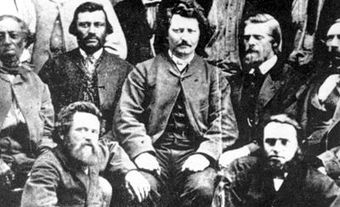The First Treaty (1854–66)
British diplomats had tried before 1852 to negotiate a reciprocity agreement in Washington, without success. Its earliest major advocate in Upper Canada was politician and businessman William Merritt.
The movement toward reciprocity began in earnest between 1846 and 1850. It became a prominent issue in Canada West (what is now Ontario) and the Maritime colonies, particularly New Brunswick. It was initiated by a dispute over the rights of American fishermen in the coastal waters of British North America (BNA). Both governments became anxious for a comprehensive settlement.
The Reciprocity Treaty was signed by BNA Governor General Lord Elgin and US Secretary of State William Marcy on 6 June 1854. It was accepted by the US Congress in August. The treaty was to remain in force for 10 years. After that, it could be terminated by either side with one year’s notice.
The treaty gave US fishermen access to the BNA’s Atlantic coastal fisheries. It also allowed BNA fishermen to fish the US coastal waters north of 36 degrees N latitude. The treaty established the free trade of a considerable number of natural resources. Trade between the US and the colonies increased sharply after 1854. However, factors other than the reciprocity agreement, such as the Canadian railway boom and the effects of the American Civil War (1861–65), were largely responsible.

Abrogation and Confederation
At first, the treaty was popular in both countries. However, it fell out of favour due to a combination of political and economic factors. Opposition in both countries centred on the fear that it would lead to the US absorbing the BNA colonies. Canadian opponents were afraid of being swallowed by the more populous and economically powerful United States. Opponents in the US feared that annexing the BNA colonies would increase the influence and power of the Northern states.
During the Civil War, Britain quietly collaborated with the Southern states. At the end of the war, Northern politicians were angry at Britain for its support of the South. They sought an end to reciprocity with the British colonies. This, coupled with the treaty’s other perceived shortcomings, prompted the US to cancel (abrogate) the treaty on 17 March 1866.
The end of the treaty strengthened the argument for a Confederation of the British North American colonies. A larger domestic Canadian market would improve trade opportunities for each individual BNA colony.
New Attempts at Reciprocity
After Confederation, Canadians wanted to renew the reciprocity agreement with the US. Political leaders John A. Macdonald, George Brown, Charles Tupper and others made “pilgrimages” to Washington, without success. A notable disappointment was Macdonald’s failure to have a large measure of reciprocity included in the 1871 Treaty of Washington.
In the 1880s, an extensive free-trade arrangement was advocated by Canadian businessmen. Erastus Wiman and Richard Cartwright were among the supporters. It was called “commercial union” or “unrestricted reciprocity.” However, these proposals were rejected during the 1891 Canadian election. This was due to protectionist and pro-British sentiments. In 1897, Liberal Prime Minister Sir Wilfrid Laurier announced: “There will be no more pilgrimages to Washington.”
The last major attempt at reciprocity was negotiated in 1911 by the Laurier government. This Reciprocity Agreement provided for the free trade of natural resources and the reduction of duties on a variety of other products. The agreement was accepted by the US Congress. However, it was rejected by Canadians, who ousted the Liberals in the general election of 21 September 1911.

End of Reciprocity
After 1911, reciprocity played a less prominent role in Canadian–American relations. In 1935, the Mackenzie King administration negotiated a trade agreement. However, it was much less sweeping in its removal of trade barriers than the treaty of 1854.
In 1938, a new and more comprehensive agreement was signed. It granted Canada additional concessions to those in the 1935 deal. However, the 1938 agreement was suspended in 1948 after both countries signed the General Agreement on Tariffs and Trade (GATT).
Free Trade Revival
In the 1980s, the Progressive Conservative government of Brian Mulroney negotiated the Canada–US Free Trade Agreement. It was signed by Mulroney and US President Ronald Reagan in 1988. Like the earlier reciprocity agreements, it eliminated many trade barriers between the two countries. It was superseded in 1994 by the North American Free Trade Agreement (NAFTA) between Canada, the US and Mexico.

 Share on Facebook
Share on Facebook Share on X
Share on X Share by Email
Share by Email Share on Google Classroom
Share on Google Classroom

